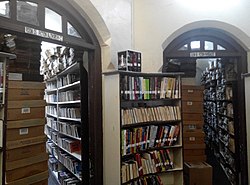
The Bahamas, officially the Commonwealth of The Bahamas, is a country in North America. It is an island country within the Lucayan Archipelago of the West Indies in the Atlantic Ocean. It contains 97% of the Lucayan Archipelago's land area and 88% of its population. The archipelagic state consists of more than 3,000 islands, cays, and islets in the Atlantic Ocean, and is located north of Cuba and northwest of the island of Hispaniola and the Turks and Caicos Islands, southeast of the U.S. state of Florida, and east of the Florida Keys. The capital is Nassau on the island of New Providence. The Royal Bahamas Defence Force describes The Bahamas' territory as encompassing 470,000 km2 (180,000 sq mi) of ocean space.
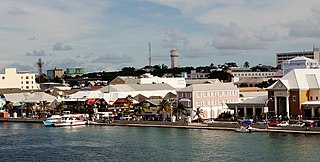
Nassau is the capital and largest city of The Bahamas. It is located on the island of New Providence, which had a population of 246,329 in 2010, or just over 70% of the entire population of The Bahamas. As of April 2023, the preliminary results of the 2022 census of the Bahamas reported a population of 296,522 for New Providence, 74.26% of the country's population. Nassau is commonly defined as a primate city, dwarfing all other towns in the country. It is the centre of commerce, education, law, administration, and media of the country.

The Bahamas are a group of about 700 islands and cays in the western Atlantic Ocean, of which only between 30 and 40 are inhabited. The largest of the islands is Andros Island, located north of Cuba and 200 kilometres southeast of Florida. The Bimini islands are to its northwest. To the North is the island of Grand Bahama, home to the second-largest city in the country, Freeport. The island of Great Abaco is to its east. In the far south is the island of Great Inagua, the second-largest island in the country. Other notable islands include Eleuthera, Cat Island, San Salvador Island, Acklins, Crooked Island, and Mayaguana. Nassau is the capital and largest city, located on New Providence. The islands have a tropical savannah climate, moderated by the Gulf Stream. The total size is 13,878 km2 (5,358 sq mi). Due to the many widespread islands it has the 41st largest Exclusive Economic Zone of 654,715 km2 (252,787 sq mi).

The New Haven Green is a 16-acre (65,000 m2) privately owned park and recreation area located in the downtown district of the city of New Haven, Connecticut, United States. It comprises the central square of the nine-square settlement plan of the original Puritan colonists in New Haven, and was designed and surveyed by colonist John Brockett. Today the Green is bordered by the modern paved roads of College, Chapel, Church, and Elm streets. Temple Street bisects the Green into upper (northwest) and lower (southeast) halves.
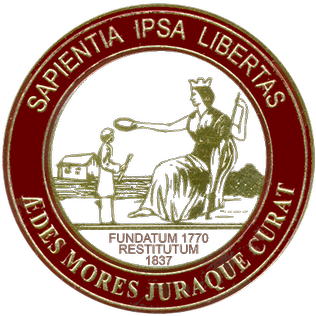
The College of Charleston is a public university in Charleston, South Carolina. Founded in 1770 and chartered in 1785, it is the oldest university in South Carolina, the 13th-oldest institution of higher learning in the United States, and the oldest municipal college in the nation.

Nassau Hall, colloquially known as Old Nassau, is the oldest building at Princeton University in Princeton, Mercer County, New Jersey, United States. In 1783 it served as the United States Capitol building for four months. At the time it was built in 1756, Nassau Hall was the largest building in colonial New Jersey and the largest academic building in the American colonies.

The University of The Bahamas (UB) is the national public institution of higher education in the Commonwealth of The Bahamas with campuses throughout the archipelago. The main campus is located in the capital city of Nassau, on the island of New Providence.

The Roman Catholic Archdiocese of Nassau is an archdiocese of the Latin Church of the Catholic Church in the Caribbean. The archdiocese encompasses the islands of the former British dependency of the Bahamas. The archbishop is the metropolitan responsible for the suffragan diocese of Diocese of Hamilton in Bermuda and the Mission sui iuris of Turks and Caicos, and is a member of the Antilles Episcopal Conference.
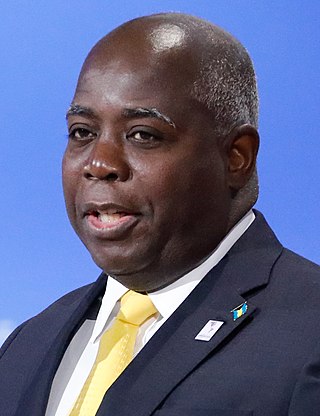
Philip Edward "Brave" Davis is a Bahamian politician serving as the prime minister of the Bahamas since 2021. He was the Member of Parliament (MP) for Cat Island, Rum Cay & San Salvador from 1992 to 1997 and returned to the seat in May 2002, which he still represents.
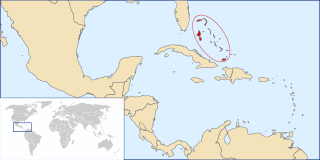
The following is an alphabetical list of topics related to the Commonwealth of The Bahamas.

Fort Charlotte is a British-colonial era fort built on a hill overlooking the harbor of Nassau, The Bahamas. The fort sits a short walk west of downtown Nassau and the cruise ship terminal. The fort was constructed in the late 18th century by British colonial governor Lord Dunmore after the end of the American Revolutionary war. The fort has never been used in battle. It is one of several English forts that are still standing in Nassau. These forts were to be used as battle stations, to attack the invading Spaniards.

The Raid on Nassau, on the Bahamian island of New Providence, was a privately raised Franco-Spanish expedition against the English taking place in October 1703, during the War of the Spanish Succession; it was a Franco-Spanish victory, leading to Nassau's brief occupation, then its destruction. The joint Bourbon invasion was led by Blas Moreno Mondragón and Clause Le Chesnaye, with the attack focusing on Nassau, the capital of the English Bahamas, an important base of privateering for English corsairs in the Cuban and Saint Domingue's Caribbean seas. The town of Nassau was quickly taken and sacked, plundered and burnt down. The fort of Nassau was dismantled, and the English governor, with all the English soldiers were carried off prisoners. A year later, Sir Edward Birch, the new English governor, upon landing in Nassau, was so distraught at the ruin he found, that he returned to England after only a few months, without "unfurling his company-issued commission".

The British Colonial Hotel is a historic resort hotel in downtown Nassau, Bahamas, located on the only private beach in Nassau, on the site of the Old Fort of Nassau. The hotel, originally opened in 1924, has been described as "the Grand Dame of all Nassau hotels", "the most elegant and most expensive hotel in town", and "the most distinctive and pleasant of the island's large hotels".
The Old Fort of Nassau, also known as Fort Nassau, was a fort in Nassau, Bahamas, first built in 1697. The fort lasted for nearly two hundred years with a rich legacy of history until it was finally demolished in 1897. It was located on the north side of Marlborough Street, on the site of the current British Colonial Hilton Nassau. Remnants of the old walls can be seen on the hotel grounds. For many years it was the only fort in Nassau.
St. Andrew's Presbyterian Kirk is a historic church in downtown Nassau, Bahamas.
Dame Doris Sands Johnson was a Bahamian teacher, suffragette, and politician. She was the first Bahamian woman to contest an election in the Bahamas, the first female Senate appointee, and the first woman granted a leadership role in the Senate. Once in the legislature, she was the first woman to be made a government minister and then was elected as the first woman President of the Senate. She was the first woman to serve as Acting Governor General of the Bahamas, and was honored as Dame Commander of the Most Excellent Order of the British Empire by Queen Elizabeth II.
The Nassau Guardian is a newspaper in The Bahamas, based in Nassau. Its first issue was published November 23, 1844. It is the largest newspaper in the Bahamas. The paper is one of the oldest continually published newspapers in the world and is considered a newspaper of record for The Bahamas.
Diane Gail North-Saunders, OBE was a Bahamian historian, archivist, athlete, and author.

The Bahamian Parliament Building is the home of the Parliament of the Bahamas. The building was constructed in 1815 and is located in the capital of Nassau.
Fox Hill Prison is the only prison in the Bahamas. Located in Nassau, the capital, it is operated by the Bahamas Department of Correctional Services. Fox Hill Prison has minimum, medium, and maximum security facilities for male prisoners. It also has one block for female prisoners, as well as a medical block.
